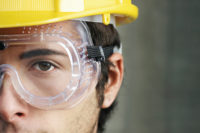Ladder safety is sometimes taken for granted because ladders are used for so many common activities in homes and other applications outside the workplace. Stored in closets, garages and sheds, they are just grabbed when needed, often without a second thought. Even children can use them without much training or oversight.
Because using a ladder is such a familiar skill that most people gain long before they enter the workforce, it can be easy to overlook the need for safe operating procedures in the workplace. However, ladders continue to be a contributing factor in more than 150 fatalities and 20,000 non-fatal workplace injuries each year, according to the Bureau of Labor Statistics (BLS), making the need for ladder safety programs real.
Hazard assessments
Some facilities choose to address ladder hazards by eliminating the use of ladders entirely. Instead of ladders, they install stairs or use mechanical lift devices to reach areas that would otherwise require the use of ladders. But for many facilities, it’s not possible or practical to completely eliminate the use of ladders.
Identifying all of the areas where ladders are currently being or could potentially be used throughout the facility is the first step in assessing hazards. Because ladders are often used for non-routine tasks that happen infrequently, this can be slightly more difficult than assessing the hazards of a process that operates daily.
Use floor plans to mark the locations of all overhead lighting, utility panels and any other item that would need to be reached using a ladder. In addition, ask maintenance staff members for details about less common tasks such as painting, maintenance, dusting or other housekeeping that requires the use of ladders.
For each task that requires a ladder to be used, determine any special circumstances that may accompany the need. For example, if the ladder will be used for electrical work, procedures for its use will need to include the instruction not to use a metal ladder.
Ladder choices
Chances are good that more than one type of ladder will be necessary for the variety of tasks that need to be performed. Creating an inventory of all ladders onsite will help determine if all of the climbing needs in the facility can be met.
The most common ladder materials are wood, aluminum and fiberglass. Each has characteristics that make it desirable for certain tasks. These same characteristics can also make it unsuitable for some applications.
Aluminum ladders are corrosion-resistant and light weight. This makes them easy to maintain, carry and maneuver. They are, however, not suitable for any type of electrical work because they will conduct electricity. Wooden ladders are also not suitable for electrical work because although wood is non-conductive, most wooden ladders have metal braces and fasteners that can conduct electricity.
When clean and dry, fiberglass ladders are a good choice when working with or near electricity. They are strong and durable, but do weigh more than aluminum ladders.
In addition to the materials that make up a ladder, the style of a ladder must also be considered.
Step ladders have A-frame designs with locking spreader bars that provide support. They commonly range from two to 20 feet in height and have a top cap that can be used to place tools or other items that the person using the ladder needs while they are on the ladder.
Extension ladders typically range from 20 to 60 feet in height. They also commonly use rope and pulleys to make extending and retracting the ladder easier. When extension ladders are extended, the sections of the ladder must overlap by at least three feet, but sometimes as much as five feet on longer ladders. Extension ladders require the support of a wall or roof for use.
Another consideration for all types of ladders is their weight capacity. Each ladder should be labeled with a duty rating. These ratings can range anywhere from 150 to 375 pounds. The weight of the person as well as any tools and equipment that they will be using on the ladder should be considered when choosing the necessary duty rating.
Ladder inspections
Ladders should be inspected prior to each use. But a BLS study of ladder-related incidents showed that 66 percent of workers who had sustained an injury involving a ladder were never taught how to inspect a ladder for defects.
No ladder lasts forever. Even properly stored and maintained ladders will warp, bow or become brittle over time and need to be replaced. Inspecting a ladder before each use will help to identify defects and ensure that the ladder is in good working condition.
Employees need to be taught what to look for when inspecting a ladder. Ladders with bent or dented side rails or rungs, and those with missing steps or rungs must be tagged and discarded. Most facilities implement the best practice of physically destroying damaged ladders to prevent anyone from using it.
Step ladders must not be used if the spreader bars are missing, damaged or do not lock. Likewise, all hinges on articulating ladders must have well-lubricated hinges that lock properly. Wooden ladders that are painted should be discarded because paint can hide structural defects.
Even though ladders should be inspected before each use and removed from service if they are damaged, it is still a good idea to do periodic audits of all ladders in inventory to make sure that each is still serviceable.
Ladder use
It is easy to find pictures and stories of people using ladders unsafely. Some use ladders unsafely or make the wrong ladder choice because they are in a hurry. Others have never been taught to use a ladder properly. In fact, BLS found that 73 percent of the workers they interviewed after an injury had not received training.
Teach workers the importance of placing ladders on firm, stable, level ground and securing the base of the ladder before climbing. When employees are climbing and descending ladders, they need to wear the proper footwear and keep their weight centered between the side rails. To maintain three points of contact when climbing and descending, tools, parts and other equipment should not be hand-carried.
Performing a thorough hazard assessment, training workers to use the right tool for the job and conducting periodic inspections all help to minimize the chance of fall-related incidents. Whether employees use ladders daily or only once or twice a year, knowing how to choose the right ladder for the job and how to use it safely will prevent injuries and deaths.



